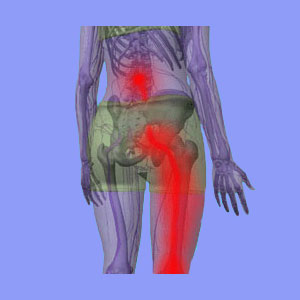
Sciatica from driving describes a scenario wherein the patient suffers the onset or intensification of symptoms while operating a motor vehicle. Many people find sitting with sciatica to be generally uncomfortable to begin with and driving to be even worse. After all, driving requires not only sitting for long periods of time, but also continuous use of the legs and feet to control the vehicle. Additionally, driving subjects the patient to significant emotional stress in the form of traffic, road rage and work-related issues.
This article will detail the occurrence of sciatica from driving a car. Learn about the physical and emotional contributory factors which might explain why driving is such a torturous activity for so many lower back and leg pain patients.
Sciatica from Driving Problems
Most people who drive need to do so in order to perform their jobs or meet family obligations and responsibilities. Driving has become an inherent part of the lives of most sciatica patients. If a person needs to drive and can not do so, they will be put under a huge amount of stress. Emotional stress can certainly cause physical pain all by itself, but it can also certainly worsen any uncomfortable symptomatic expression, including sciatica.
People who endure sciatica while attempting to drive might be suffering from a structurally-induced pain syndrome in the lumbar spine, such as a herniated disc. These concerns are known to become exacerbated when the person is forced to sit for any length of time. When a structural issue exists, it should be studied to ascertain if the problem is likely to become worse when seated. For certain types of low back issues, the answer may be yes, while in others, there may be no logic in assuming that sitting is escalating the symptoms through purely structural means.
A good example is when the patient has been diagnosed with lumbar central spinal stenosis, yet suffers increased pain while sitting. Since the seated posture actually increases the size of the spinal canal, this would be an illogical expression to suffer.
However, many patients suffer pain due to pure psychological conditioning, not any tangible structural reason. They might have experienced pain while sitting early in their back pain experience and now have come to fear sitting every time.
They might have also been warned by a doctor or fellow patient that sitting can produce pain. Both of these situations can create programmed responses to sitting through real world experience or the psychological nocebo effect.
Mindbody Sciatica
As previously mentioned, driving is typically linked to other sources of potential emotional stress, such as work and family. The subconscious mind does not always behave as we would hope or like, and might create physical pain as a means of hiding repressed, deeply-held and sensitive emotions relating to activities, events, memories or people in our lives.
This is known scientific fact and the basis of the tension myositis syndrome diagnosis propagated by the world famous Dr. John Sarno. Patients who do not have an obvious reason for sitting-related low back pain may be suffering from symptoms which come on in association with these troublesome emotional issues. This is a consideration rarely discussed during sciatica diagnosis, which is truly a shame. Remember, that some unresolved chronic back pain complaints are caused, perpetuated or worsened by purely emotional phenomenon.
Additionally, even when not directly caused by mindbody interactions, virtually all chronic pain syndromes do have some contributory emotional component. This is a universal truth of the epidemic of mindbody disorders which are presently plaguing our healthcare system worldwide.
Overcoming Sciatica from Driving
While there are a number of products on the market to reduce lower back strain while driving, I do not recommend or endorse any. Most of these do not have any true efficacy and only seek to make some greedy corporation money from your suffering. Car seat cushions, massage cushions and seated back braces may provide creature comforts, but they are unlikely to be the solution to ending your pain.
It is rare that a long-term sciatica pain syndrome will come about as a result of a purely physical condition. Usually, these structural issues are discovered and successfully corrected during the typical barrage of treatments attempted by most patients.
Chronic symptoms usually continue because they have never been accurately diagnosed. There may be another spinal or non-spinal cause for pain to occur when driving. They may also be a nonstructural ischemic pain syndrome at the heart of the problem. Do not discount the ability of the mind to cause or cure pain throughout the body. As a final thought, it is wise to remember that the body is the soldier, while the mind is definitely the general.
To learn more about how to reduce the severity of sciatica from driving, talk to your physician or physical therapist to determine if the structural cause of pain is likely to be worsened from the static seated posture and leg movements associated with operating your car. If no correlation is made, then it may be time to consider the less obvious sources of pain which seem to present themselves while driving, such as stress.





